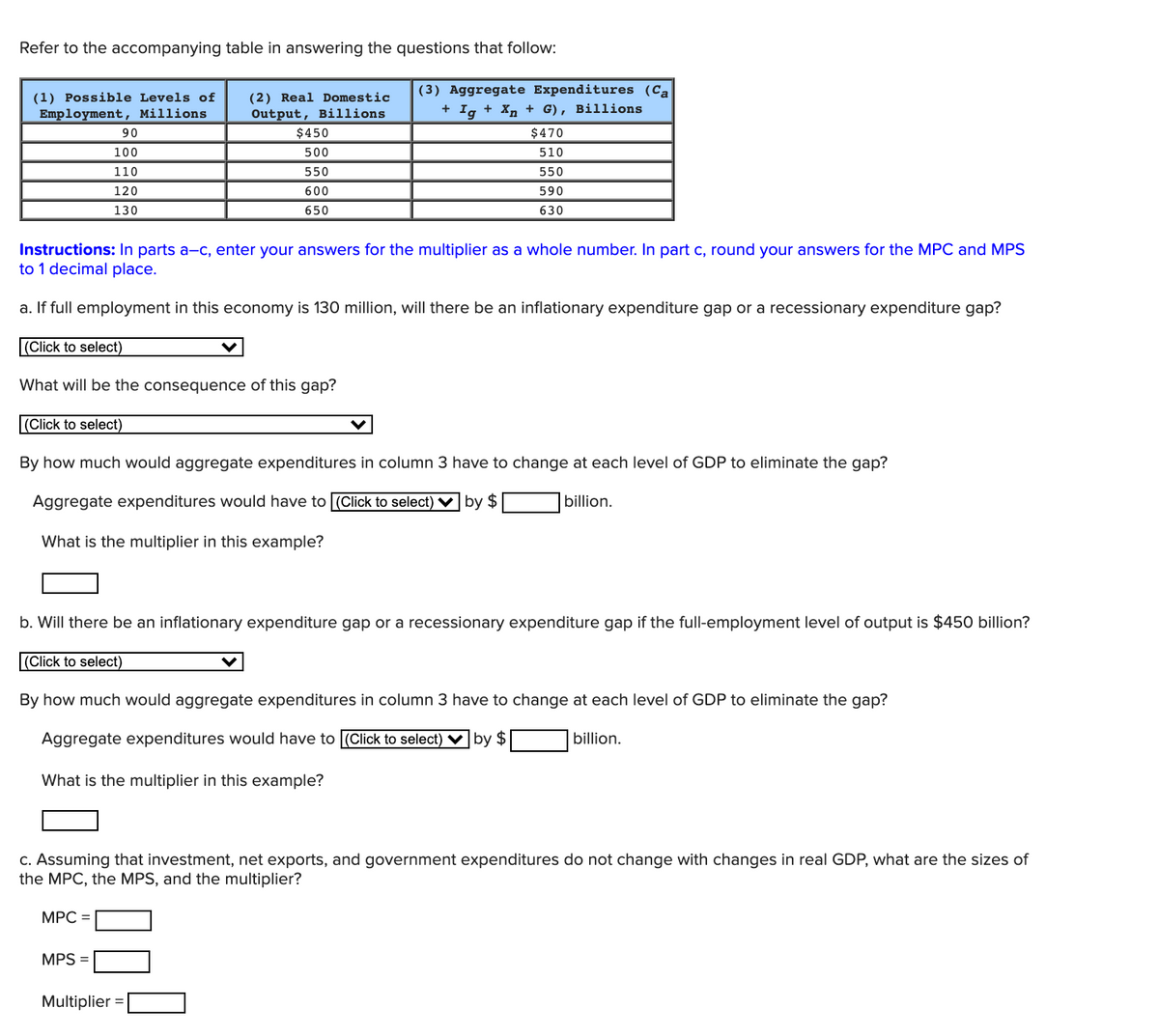a. If full employment in this economy is 130 million, will there be an inflationary expenditure gap or a recessionary expenditure gap? (Click to select) What will be the consequence of this gap? (Click to select) By how much would aggregate expenditures in column 3 have to change at each level of GDP to eliminate the gap? Aggregate expenditures would have to (Click to select) ♥] by $ |billion. What is the multiplier in this example? b. Will there be an inflationary expenditure gap or a recessionary expenditure gap if the full-employment level of output is $450 billion? (Click to select) By how much would aggregate expenditures in column 3 have to change at each level of GDP to eliminate the gap? Aggregate expenditures would have to (Click to select) ♥ by $ billion. What is the multiplier in this example? c. Assuming that investment, net exports, and government expenditures do not change with changes in real GDP, what are the sizes of the MPC, the MPS, and the multiplier? MPC =| MPS = Multiplier =
a. If full employment in this economy is 130 million, will there be an inflationary expenditure gap or a recessionary expenditure gap? (Click to select) What will be the consequence of this gap? (Click to select) By how much would aggregate expenditures in column 3 have to change at each level of GDP to eliminate the gap? Aggregate expenditures would have to (Click to select) ♥] by $ |billion. What is the multiplier in this example? b. Will there be an inflationary expenditure gap or a recessionary expenditure gap if the full-employment level of output is $450 billion? (Click to select) By how much would aggregate expenditures in column 3 have to change at each level of GDP to eliminate the gap? Aggregate expenditures would have to (Click to select) ♥ by $ billion. What is the multiplier in this example? c. Assuming that investment, net exports, and government expenditures do not change with changes in real GDP, what are the sizes of the MPC, the MPS, and the multiplier? MPC =| MPS = Multiplier =
Macroeconomics: Principles and Policy (MindTap Course List)
13th Edition
ISBN:9781305280601
Author:William J. Baumol, Alan S. Blinder
Publisher:William J. Baumol, Alan S. Blinder
Chapter8: Aggregate Demand And The Powerful Consumer
Section: Chapter Questions
Problem 8DQ
Related questions
Question

Transcribed Image Text:Refer to the accompanying table in answering the questions that follow:
(3) Aggregate Expenditures (Ca
(1) Possible Levels of
Employment, Millions
(2) Real Domestic
Output, Billions
+ Ig
Хр, + G), вillions
90
$450
$470
100
500
510
110
550
550
120
600
590
130
650
630
Instructions: In parts a-c, enter your answers for the multiplier as a whole number. In part c, round your answers for the MPC and MPS
to 1 decimal place.
a. If full employment in this economy is 130 million, will there be an inflationary expenditure gap or a recessionary expenditure gap?
(Click to select)
What will be the consequence of this gap?
(Click to select)
By how much would aggregate expenditures in column 3 have to change at each level of GDP to eliminate the gap?
Aggregate expenditures would have to (Click to select) ♥ by $
billion.
What is the multiplier in this example?
b. Will there be an inflationary expenditure gap or a recessionary expenditure gap if the full-employment level of output is $450 billion?
(Click to select)
By how much would aggregate expenditures in column 3 have to change at each level of GDP to eliminate the gap?
Aggregate expenditures would have to (Click to select) V by $
billion.
What is the multiplier in this example?
c. Assuming that investment, net exports, and government expenditures do not change with changes in real GDP, what are the sizes of
the MPC, the MPS, and the multiplier?
MPC =
MPS =
Multiplier =
Expert Solution
This question has been solved!
Explore an expertly crafted, step-by-step solution for a thorough understanding of key concepts.
This is a popular solution!
Trending now
This is a popular solution!
Step by step
Solved in 2 steps with 5 images

Knowledge Booster
Learn more about
Need a deep-dive on the concept behind this application? Look no further. Learn more about this topic, economics and related others by exploring similar questions and additional content below.Recommended textbooks for you

Macroeconomics: Principles and Policy (MindTap Co…
Economics
ISBN:
9781305280601
Author:
William J. Baumol, Alan S. Blinder
Publisher:
Cengage Learning


Macroeconomics: Principles and Policy (MindTap Co…
Economics
ISBN:
9781305280601
Author:
William J. Baumol, Alan S. Blinder
Publisher:
Cengage Learning
